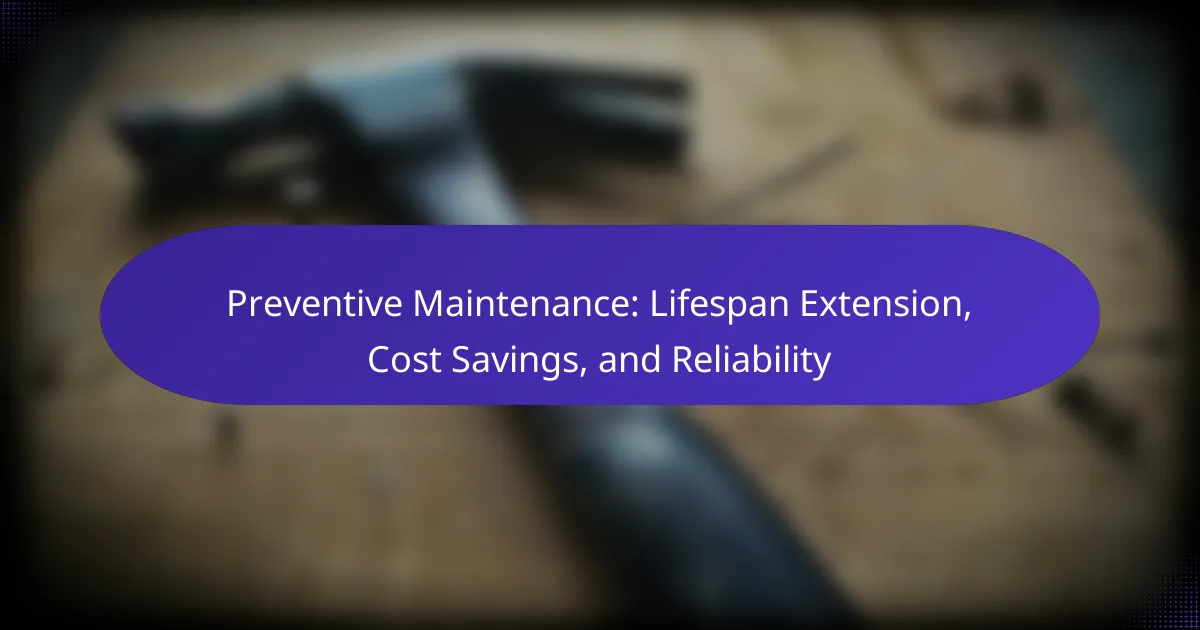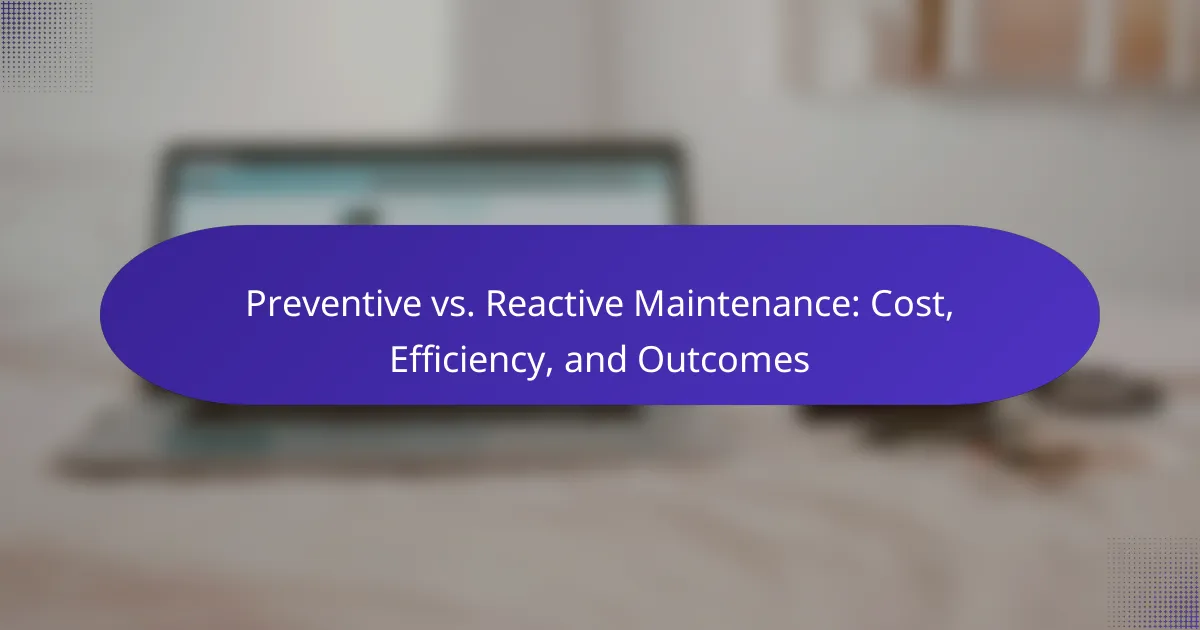Preventive maintenance is a proactive strategy that significantly extends the lifespan of equipment by identifying and addressing potential issues before they lead to major failures. This method not only enhances the reliability of assets but also results in substantial cost savings by minimizing unexpected repair expenses and operational disruptions. By committing to regular maintenance, businesses can ensure smoother operations and lower overall costs.
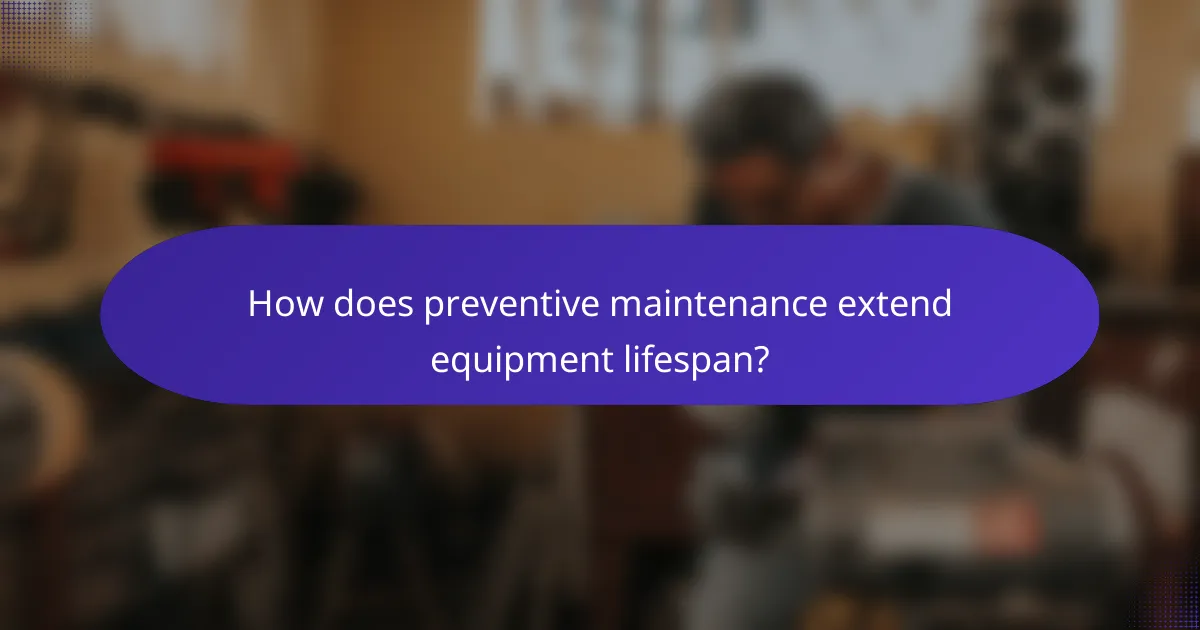
How does preventive maintenance extend equipment lifespan?
Preventive maintenance extends equipment lifespan by proactively addressing potential issues before they escalate into major failures. This approach not only enhances reliability but also reduces the frequency and cost of repairs over time.
Regular inspections
Conducting regular inspections is crucial for identifying wear and tear on equipment. These inspections should be scheduled based on usage patterns, typically ranging from weekly to monthly, depending on the equipment’s operational demands.
During inspections, technicians can check for signs of damage, fluid leaks, and other indicators of potential failure. Documenting findings helps track the condition of equipment and informs future maintenance decisions.
Timely repairs
Timely repairs are essential to prevent minor issues from developing into significant problems. Addressing repairs as soon as they are identified can save costs and downtime, as waiting too long can lead to more extensive damage.
Establish a protocol for prioritizing repairs based on severity and impact on operations. This ensures that critical equipment remains functional and minimizes disruptions to productivity.
Component replacements
Replacing worn or outdated components is a key aspect of preventive maintenance that directly contributes to extending equipment lifespan. Components such as filters, belts, and bearings should be replaced according to manufacturer recommendations or when performance declines.
Implementing a systematic replacement schedule helps maintain optimal performance and reduces the risk of unexpected failures. Keeping an inventory of critical spare parts can also facilitate quicker replacements and minimize downtime.
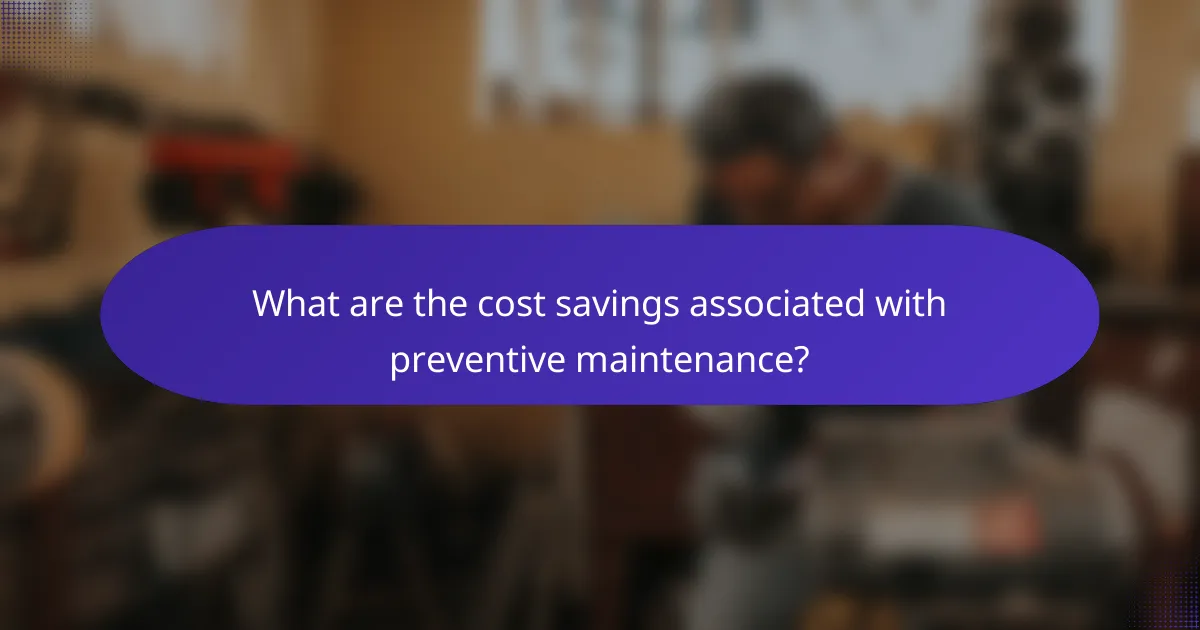
What are the cost savings associated with preventive maintenance?
Preventive maintenance can lead to significant cost savings by reducing unexpected repair expenses and minimizing operational disruptions. By investing in regular maintenance, businesses can enhance equipment reliability and extend the lifespan of assets, ultimately leading to lower overall costs.
Reduced repair costs
Preventive maintenance helps identify and address potential issues before they escalate into major repairs. By regularly servicing equipment, businesses can avoid costly breakdowns that often require expensive parts and labor. For example, a small investment in routine inspections can prevent a failure that might otherwise cost thousands of dollars to fix.
Additionally, maintaining equipment in good condition can lead to better performance and efficiency, which can further reduce operational costs. Companies often find that spending a fraction of repair costs on preventive measures yields substantial savings over time.
Lower downtime expenses
Downtime can be one of the most significant costs associated with equipment failure. Preventive maintenance minimizes the risk of unexpected breakdowns, allowing operations to run smoothly without interruptions. Each hour of downtime can cost businesses hundreds to thousands of dollars, depending on the industry and scale of operations.
By scheduling maintenance during off-peak hours, companies can further reduce the impact of downtime. This proactive approach ensures that equipment is serviced without disrupting production schedules, leading to increased productivity and profitability.
Extended warranty benefits
Many manufacturers offer extended warranties for equipment that is regularly maintained according to their specifications. By adhering to recommended maintenance schedules, businesses can qualify for these warranties, which can cover repair costs that would otherwise be out-of-pocket expenses.
Moreover, maintaining equipment properly can prevent warranty claims from being denied due to neglect. Companies should keep detailed records of maintenance activities to ensure compliance with warranty terms, maximizing their benefits and protecting their investments.
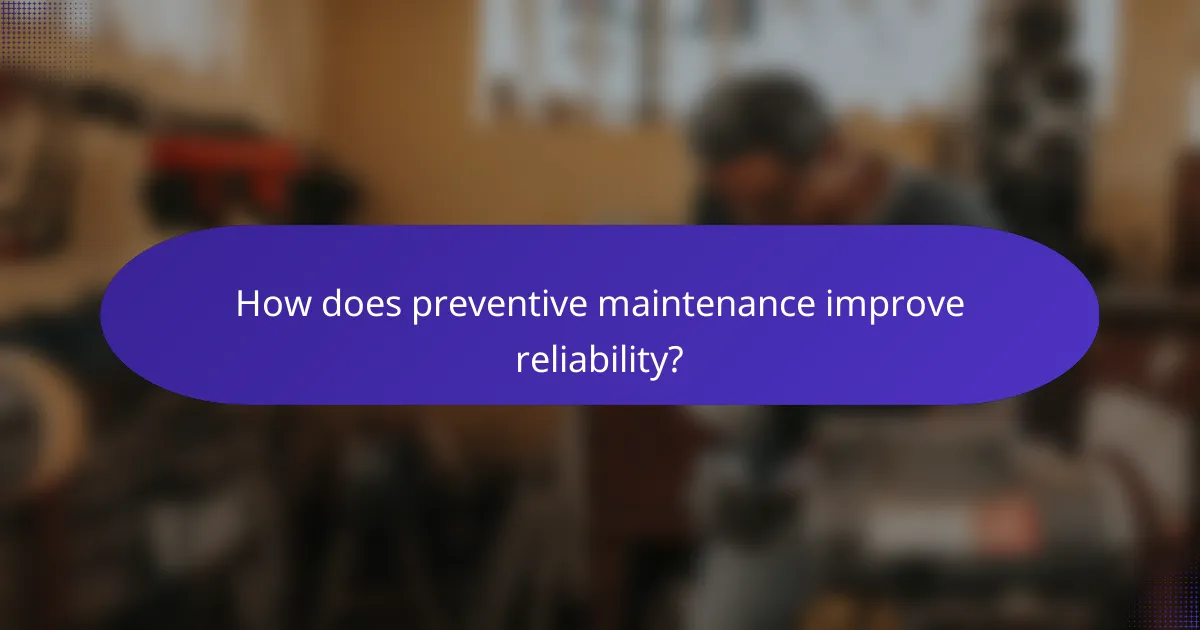
How does preventive maintenance improve reliability?
Preventive maintenance enhances reliability by systematically addressing potential issues before they escalate into significant problems. Regular inspections and timely repairs help ensure that equipment operates smoothly and efficiently, reducing the likelihood of breakdowns.
Consistent performance
Consistent performance is achieved through regular maintenance checks that keep equipment functioning at optimal levels. By adhering to a maintenance schedule, organizations can ensure that machinery operates within specified parameters, leading to predictable output and quality.
For example, in manufacturing, routine calibration of machines can prevent variations in product quality, ensuring that production meets standards consistently. This reliability fosters trust among customers and stakeholders.
Minimized unexpected failures
Preventive maintenance significantly reduces the risk of unexpected failures by identifying and rectifying issues early. Regularly scheduled inspections allow for the detection of wear and tear before it leads to equipment failure.
For instance, a fleet of delivery vehicles that undergoes routine checks is less likely to experience breakdowns on the road, which can be costly in terms of repairs and lost time. This proactive approach can save businesses substantial amounts in emergency repair costs.
Enhanced safety standards
Enhanced safety standards are a direct benefit of preventive maintenance, as it helps ensure that equipment complies with safety regulations. Regular maintenance checks can identify hazards, such as faulty wiring or worn-out parts, that could pose risks to operators and the surrounding environment.
In industries like construction, adhering to safety protocols through consistent maintenance not only protects workers but also minimizes liability for the company. Investing in preventive measures can lead to a safer workplace and potentially lower insurance premiums.

What factors influence preventive maintenance strategies?
Preventive maintenance strategies are influenced by several key factors, including the type of equipment, the operating environment, and how frequently the equipment is used. Understanding these factors helps organizations tailor their maintenance plans to enhance reliability and extend the lifespan of their assets.
Equipment type
The type of equipment significantly affects preventive maintenance strategies. Different machines have varying maintenance requirements based on their complexity, function, and manufacturer recommendations. For instance, heavy machinery may require more frequent inspections and servicing compared to simpler tools.
It’s essential to consult the equipment’s manual for specific maintenance schedules and guidelines. Adhering to these recommendations can prevent unexpected breakdowns and costly repairs.
Operating environment
The operating environment plays a crucial role in determining maintenance needs. Equipment used in harsh conditions, such as extreme temperatures, high humidity, or dusty environments, may require more frequent maintenance to ensure optimal performance. For example, machinery in a manufacturing plant may face different challenges than equipment used in a cleanroom setting.
Regular assessments of the operating environment can help identify potential risks and inform adjustments to maintenance schedules. Implementing protective measures, such as enclosures or filters, can also extend equipment life in challenging conditions.
Usage frequency
How often equipment is used directly impacts its maintenance requirements. High-usage equipment typically experiences more wear and tear, necessitating more frequent inspections and servicing. For example, a delivery vehicle that operates daily will require more regular maintenance than one used sporadically.
Establishing a usage log can help track equipment operation and inform maintenance schedules. This proactive approach ensures that preventive measures are aligned with actual usage patterns, reducing the risk of unexpected failures.
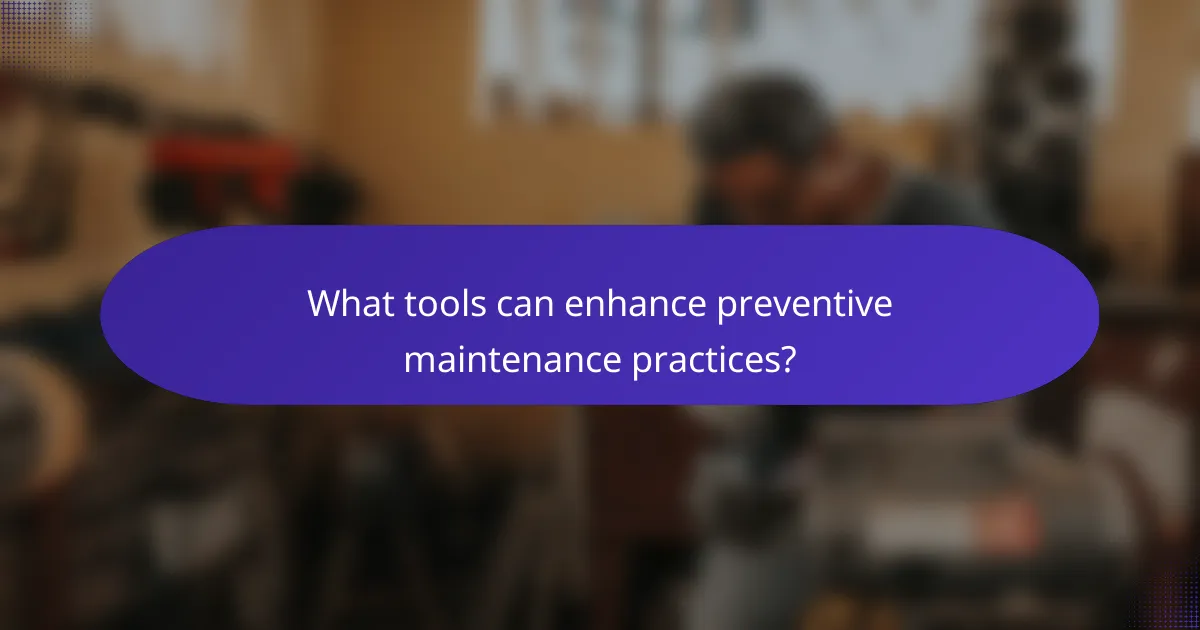
What tools can enhance preventive maintenance practices?
Several tools can significantly improve preventive maintenance practices, leading to increased efficiency and reduced costs. Key technologies include Computerized Maintenance Management Systems (CMMS), IoT sensors, and predictive analytics, each offering unique benefits for managing maintenance tasks.
CMMS software
CMMS software streamlines maintenance management by organizing work orders, tracking asset performance, and scheduling preventive tasks. This centralized approach helps maintenance teams prioritize their efforts and ensures that critical tasks are not overlooked.
When selecting a CMMS, consider features such as mobile access, reporting capabilities, and integration with existing systems. Popular options include Fiix, Hippo, and Maintenance Connection, which can cater to various organizational sizes and needs.
IoT sensors
IoT sensors play a crucial role in preventive maintenance by providing real-time data on equipment conditions. These sensors can monitor variables such as temperature, vibration, and humidity, allowing for timely interventions before failures occur.
Implementing IoT sensors requires an upfront investment but can lead to significant long-term savings by reducing downtime and maintenance costs. Choose sensors that are compatible with your existing systems and ensure they comply with relevant industry standards.
Predictive analytics
Predictive analytics uses historical data and machine learning algorithms to forecast equipment failures and maintenance needs. By analyzing patterns, organizations can schedule maintenance activities more effectively, minimizing unplanned downtime.
To leverage predictive analytics, invest in software that can integrate with your CMMS and IoT sensors. This combination allows for a comprehensive view of asset health and can enhance decision-making processes regarding maintenance strategies.
